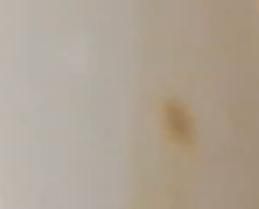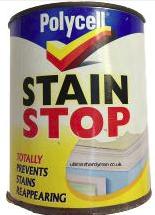Damp patches on internal walls
Damp patches on internal walls are very common, especially in some older houses. Identifying the exact cause is not always easy as the problem could be caused by condensation, rising damp, penetrating damp or something bridging the cavity. You might even have a combination of all the above problems which are causing your damp patches.

This unsightly damp patch is on a kitchen wall (cavity wall) approximately 5 feet from the floor level. The chances are that this damp patch is being caused by something bridging the cavity, such as some debris that has dropped down and is lodged between the two cavity walls. To check this the best option is to measure exactly where it is and then remove a brick from the outside of the property to investigate. You are probably wondering how something lodged in the cavity can cause a damp patch on the inside of the property, there are two main causes. Firstly the bridging of the cavity is causing a cold spot on the inside wall, this then attracts the moisture that is in the air (condensation). Secondly the debris in the cavity could be caused by penetrating damp that is getting in through damaged pointing on the external leaf of the property and is being transferred to the inside, cavity cleaning can often fix this problem

Before you go reaching for the stain blocker you need to fix the underlying problem or else you will be wasting your time ( and money ).
Firstly you need to ascertain exactly what is causing the damp patch to appear before suitable remedial action is taken, the information below should help-
Damp patches near to ground level
Damp patch/patches at ground level or close to the ground could be caused by rising damp, although rising damp does not normally appear in patches it can do under the right circumstances. It's common for houses to have damp proof courses, if something has bridged the DPC or the DPC has failed there is a chance that damp is rising up the inside wall. If the property has been dry lined using the dot and dab method there is a chance that the damp is transferring from the masonry wall to the plasterboard where the dab of drywall adhesive is.
Damp Chimney breast
Chimney breast's can often suffer from damp patches, this can be caused by poor ventilation (damp air trapped inside a disused chimney) or by penetrating damp. If the damp patch is high up against the ceiling it is likely to be penetrating damp. If the fireplace has been blocked up and no vent has been fitted there is a chance that moisture is trapped inside of the chimney and is causing the damp patches.
Retrofit cavity wall insulation
Retrofit cavity wall insulation can in some cases cause real problems in some houses. A friend of mine had retrofit cavity wall insulation installed and the pointing was not 100% waterproof, this allowed water into the cavity which in turn wet the cavity wall insulation. Because the air vents in the wall were blocked up and the cavity was full of insulation there was no chance of the insulation drying out. The property suffered from a severe case of damp patches on most external walls of the property. Bricks had to be removed and the insulation had to be removed!
Damp patch in middle of wall
Damp patches in the middle of a wall (not close to the ground, or high up in a corner) are often caused by something bridging the cavity. A good way to check is to remove a brick in the exact place on the outside wall of the property and check. This is a relatively simple job and is described here- replacing a brick. You should also check the external wall has air vents and that they are clear and not blocked. Fitting air vents is similar to replacing a brick and can be seen here- Fitting an air brick



